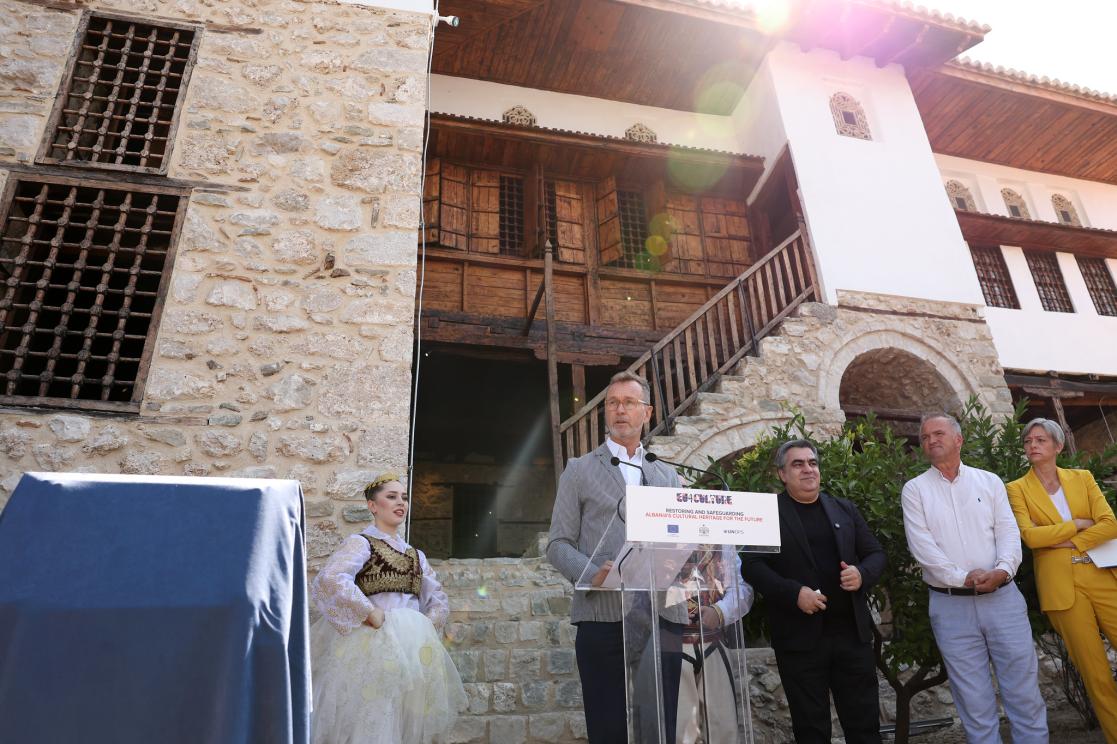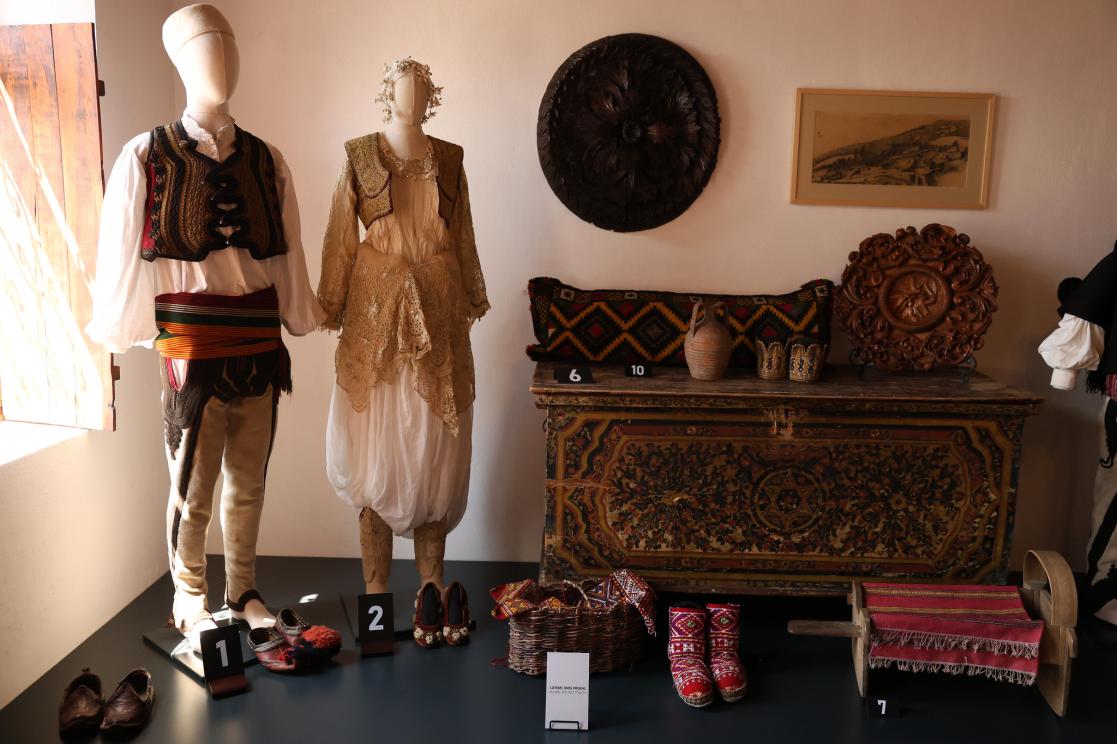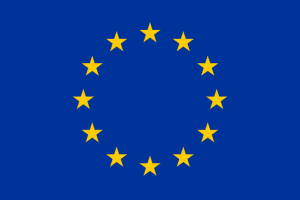The ethnography of a city in a museum, costumes, traditions and rites

Four male figures in their daily activities, a shepherd, a blacksmith forging metal, a man processing the wool to produce the “shajak” and a potter working with clay are shown on a video mapping on the amphorae. These men’s silhouettes, which look like drawings in motion that demonstrate old working methods, create a meeting moment with what used to be the past of the city of Kruja, its crafts, traditions and rites. This is a novelty in the Ethnographic Museum of Kruja, where old techniques like pottery making, metal working, leather processing, raki production, food processing and storage, olive oil production, are being displayed next to a wax sculpture representing an Albanian man, dressed in his traditional outfit while working the mill. Several rooms show everyday life and how the Albanian society was organized up to centuries ago, exposing around 1000 artifacts, including handmade kitchen utensils, inherited from generations and preserved.

EU Delegation to Albania
The museum has just reopened its doors, after a two-year restoration work, with the support of European Union through the EU4Culture programme. The intervention project included structural consolidation after significant damages caused by the 2019 earthquake. Exterior, interior and roof preservation works, artifacts restoration, historical furniture and wall paintings conservation to improve the legibility of the form, new design of museum displays and multimedia interpretation, combining Albanian heritage with innovative digital experiences, all in one.
During the reopening ceremony in July, the Minister of Economy, Culture and Innovation, Blendi Gonxhja, remarked that “I am certain that complete reconceptualization of this space, new ways to display the artifacts, along with the addition of interactive elements will increase the fascinating power that this museum has, offering a unique and unforgettable experience for everyone”.
Mentioning the importance of preserving the skills and techniques which have produced such beautiful objects and the possibility to show visitors not simply exhibiting objects, but what Albania has been, is and stands for, the EU Ambassador, Silvio Gonzato, added: “EU4Culture is not just about renovating buildings or exhibiting artifacts. It’s about showcasing Albania’s cultural identity. When we know who we are and where we come from, we are not afraid of diversity, of other cultures and traditions. That is why through this museum, and the EU4Culture programme, we are not just preserving the Albanian heritage, but also promoting a more inclusive society”.

EU Delegation to Albania
Men’s and bride’s rooms and virtual experience
The Ethnographic Museum in Kruja is housed in a historical residential building which was originally the Toptani Family’s living quarters. Probably built in 1764, it is a representative example of the 18th century residences, with a closed porch, a typical pattern for the era. Surrounded by a courtyard which is closed with a low masonry wall, the surface area of the house is divided between two floors of almost equal size, interconnected by a stone staircase. The renovated museum displays are augmented with playful and educational multimedia content, featuring a VR experience of wedding traditions, a virtual dressing room, sound effects of a hamam, audio guides, tablets showcasing the visual reproduction of crafts and video mapping projections over historical pottery.

EU Delegation to Albania
As every room has its own concept, men’s and bride’s rooms are quite different from the others, as they have wall paintings. Men’s room, otherwise known as the guest's room also, has many decorative elements including murals and wood paintings, on both sides of the fireplace. The wall spaces show arabesque motifs elegantly and skilfully interwoven with floral motifs. In the men's/guest’s room the colours used in the paintings are red, black and grey, while in the bride's room the floral motifs painted in the a-secco technique are quite restrained. Ochre and green dominate on a background of white, black, a tonality of violet and pink colours. The paintings show different themes, including portraits of men with moustaches with trees acting as their background, old edifices, a mosque, a boat with armed men, two lions similar to the Venetian ones, or elements that remind visitors of a coat of arms or an emblem. Bride’s and men’s rooms are painted by two different painters, as the specialists who worked on restoration note. Because of infiltration of the rain from the roof, damages caused by the earthquake and abrasions the whole surface of the paintings in both rooms has undergone restoration. Nowadays, the same walls fully display motifs and symbols that describe cultural elements and the lifestyle of the region during the18th century.
With an innovative narrative, detailed in every space but that does not interfere with the historical values, the new musealization creates a sense of belonging with the past, through technology. Another dimension offering a unique opportunity to understand and almost live the everyday life of the city three centuries ago is the wedding shown in a 360° movie. A TV screen placed in the bride’s room reproduces the rituals of marriage in the local culture. Each ritual is also enhanced by the usage of text narrative. Through the same technology, men and women, wearing their special day clothes, invite visitors to the wedding.

EU Delegation to Albania
One of the museum’s highlights is a virtual dressing room, which allows visitors to take selfies while (virtually) wearing traditional clothing dating from the 18th century. Costumes, including the famous Xhubleta- a handcrafted garment worn by highland women and girls in Northern Albania, lately world heritage, is also exposed at the same space where traditional men’s, women’s clothes, bride’s dress and the typical accessories, groom’s outfit are shown, differing clothes for city and village inhabitants. For sure, this museum is a ticket to travel in time and now, thanks to its innovative technology, even a quick selfie while impersonating an 18thcentury Albanian is also possible.
Background information
The EU4Culture programme is funded by the European Union (EU) and is implemented by the United Nations Office for Project Services (UNOPS) in close partnership with the Ministry of Economy, Culture and Innovation. It focuses on renovation and revitalisation of 23 major cultural heritage sites damaged by the earthquake in 2019 and represents one of the largest cultural heritage programmes funded by the European Union with a total budget of € 40 million. It aims to enhance Albania’s tourism potential, thus directly contributing to local and regional socio-economic recovery. To that aim, special focus is given to innovative technologies, including digital story-telling and creation of multimedia products designed to be accessible for all. At the same time, the programme is supporting local entrepreneurship, artisanship and cultural initiatives evolving around selected sites through the allocation of grants, providing a direct boost to the local economy.





